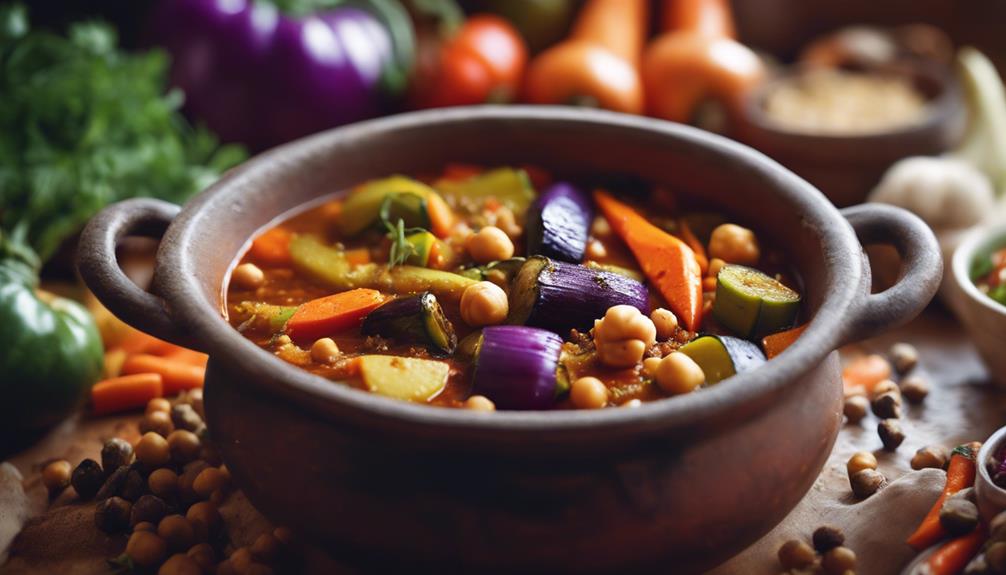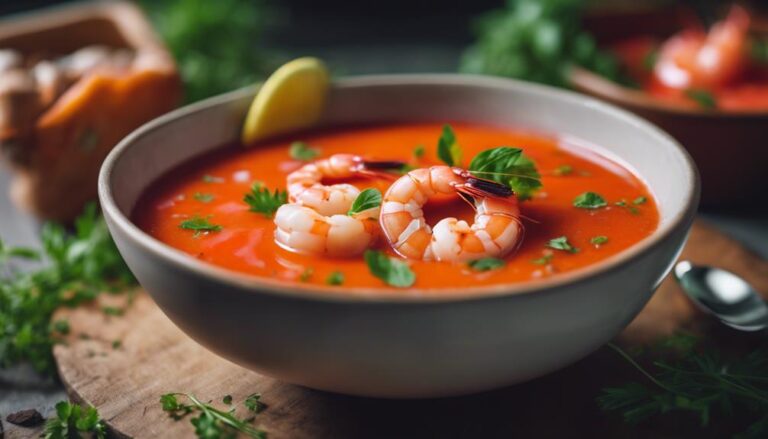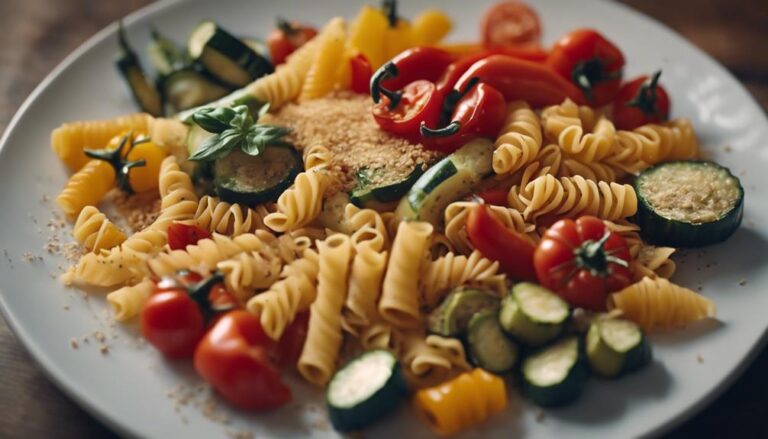Moroccan Spiced Vegetable Stew
For a taste of Morocco in your own kitchen, try Moroccan Spiced Vegetable Stew. This hearty dish combines aromatic spices like cumin, coriander, and cinnamon with a medley of vegetables for a flavorful exploration. The slow simmering method allows the ingredients to meld together, creating a rich and complex taste profile. With each spoonful, you'll experience a burst of North African flavors that will surely satisfy your palate. If you want to explore more about the fascinating world of Moroccan cuisine, venture further into the fusion of traditional spices and global culinary influence.
What You Will Learn Here
- Moroccan Spiced Vegetable Stew is a traditional North African dish.
- It features a blend of spices like cumin, coriander, and cinnamon.
- Slow-cooking method enhances flavors and textures.
- Vegetables like carrots, eggplant, and zucchini are commonly used.
- The stew is often served with couscous or crusty bread.
Culinary Roots in North Africa

North African culinary traditions are rich in history and flavor.
Traditional spices like cumin, cinnamon, and paprika infuse dishes with a unique taste.
These flavors have spread globally, influencing diverse cuisines around the world.
North African Culinary Origins
Exploring the culinary origins of North Africa reveals a rich tapestry of flavors and techniques that have influenced dishes around the world. North African cuisine is a result of cultural fusion, blending influences from Berber, Arab, and Mediterranean traditions. Traditional techniques like slow-cooking in tagines and using a variety of spices are hallmarks of North African cooking.
Modern interpretations of North African cuisine have led to fusion dishes that combine traditional flavors with contemporary cooking methods. The use of ingredients like couscous, preserved lemons, and harissa in fusion recipes showcases the diversity and adaptability of North African culinary roots.
North African cuisine has a long history of incorporating ingredients like cumin, coriander, and cinnamon to create complex and aromatic flavors. The region's cuisine is known for its bold and vibrant tastes, making it a favorite among food enthusiasts seeking new and exciting culinary experiences. The culinary origins of North Africa continue to inspire chefs and food lovers worldwide, showcasing the rich heritage and diverse flavors of the region.
Traditional Spices and Flavors
Traditional North African cuisine is renowned for its vibrant array of spices and flavors that form the very essence of its culinary roots. When exploring a North African spice market, you'd encounter a mesmerizing blend of aromas and colors, from earthy cumin to fiery harissa. These spices aren't just ingredients; they're the heart and soul of traditional cooking techniques passed down through generations.
In North African cuisine, there's a beautiful cultural fusion that celebrates flavorful combinations. The marriage of sweet dates with savory lamb, or the aromatic blend of cinnamon and cumin in a tagine, exemplifies the intricate tapestry of flavors found in this region. Traditional cooking methods like slow simmering and clay pot cooking enhance the depth of these flavors, creating dishes that are rich and complex.
Exploring the traditional spices and flavors of North Africa not only offers a sensory experience but also provides insight into the history and heritage of a cuisine that continues to influence culinary practices around the world.
Influence on Global Cuisine
Immerse yourself in the global culinary landscape by delving into the rich and diverse roots of North African cuisine. Moroccan cuisine, with its vibrant flavors and aromatic spices, has made a significant impact on global gastronomy through cultural fusion and global influences. The use of ingredients like cumin, coriander, and cinnamon in Moroccan dishes has inspired chefs worldwide to experiment with new flavor combinations.
Traditional techniques, such as slow cooking in tagines, have been adapted with modern twists in restaurants around the world. The balance of sweet and savory flavors in dishes like Moroccan spiced vegetable stew showcases the complexity and depth of North African culinary traditions. By incorporating these elements into their menus, chefs pay homage to the culinary heritage of the region while creating innovative and exciting dishes for a contemporary audience.
Whether you're enjoying a bowl of Moroccan spiced vegetable stew in a trendy urban eatery or trying your hand at recreating the flavors at home, the influence of North African cuisine on global gastronomy is undeniable.
Key Ingredients in Moroccan Cuisine
When preparing Moroccan cuisine, essential ingredients like aromatic spices, fresh herbs, and dried fruits play a significant role in creating rich and flavorful dishes. These key ingredients in Moroccan cooking are essential to achieving the unique flavor profiles and cultural significance of the cuisine.
Some important ingredients include:
- Ras el Hanout: A complex spice blend featuring a mix of warm, sweet, and aromatic flavors.
- Preserved Lemons: Briny and tangy, adding a unique depth of citrus flavor to dishes.
- Cilantro and Mint: Fresh herbs that bring a invigorating and vibrant touch to many Moroccan recipes.
- Dates and Apricots: Dried fruits that provide a subtle sweetness and chewy texture to both savory and sweet dishes.
Understanding and using these ingredients in traditional cooking techniques or modern adaptations can elevate your Moroccan-inspired dishes to new heights, capturing the essence of Moroccan cuisine in every bite.
Savory Moroccan Dishes
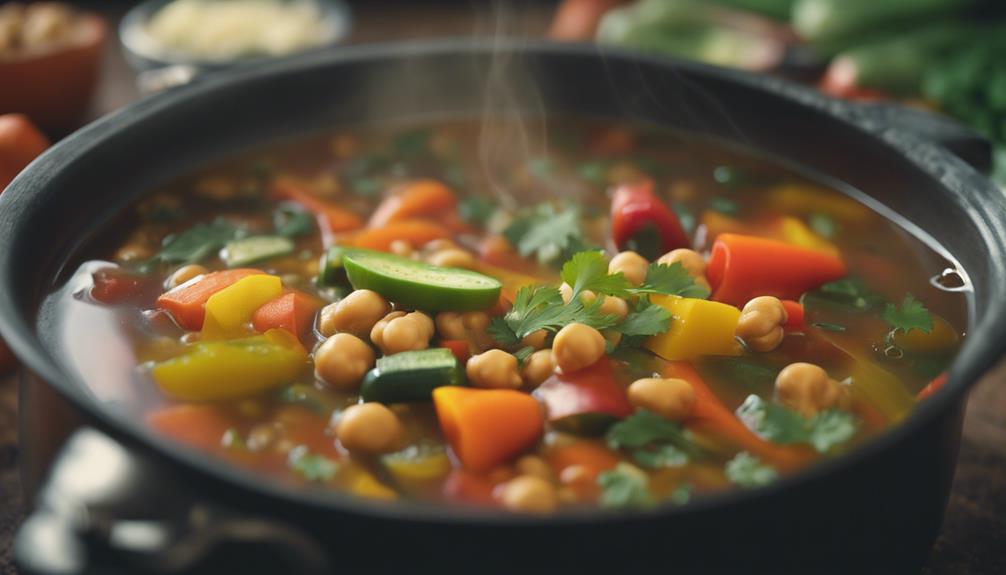
When it comes to savory Moroccan dishes, you have a variety of flavorful options to choose from.
Some popular choices include Spiced Vegetable Tagine, Chickpea and Apricot Stew, and Tangy Lemon Chicken Tagine.
These dishes showcase the rich blend of spices and ingredients that make Moroccan cuisine so unique and delicious.
Spiced Vegetable Tagine
To explore the world of savory Moroccan dishes, immerse yourself in the delightful flavors of a Spiced Vegetable Tagine. This traditional dish offers a burst of authentic flavors that will transport you to the bustling markets of Morocco. Here are some key aspects to ponder when delving into the world of Spiced Vegetable Tagine:
- Vegetarian Alternatives: Embrace the rich culinary heritage of Morocco with vegetarian twists on classic recipes. Discover how vegetables and a blend of aromatic spices create a satisfying and wholesome meal.
- Classic Recipes: Explore traditional recipes passed down through generations, showcasing the time-honored techniques and flavors that define Moroccan cuisine.
- Cooking Techniques: Learn the art of slow cooking in a tagine pot, allowing the ingredients to meld together and develop deep, complex flavors.
- Authentic Flavors: Experience the vibrant and bold flavors of Moroccan cuisine, with a harmony of spices like cumin, cinnamon, and saffron infusing every bite with warmth and depth.
Chickpea and Apricot Stew
Discover the tantalizing blend of chickpeas and apricots in this savory Moroccan stew that will transport your taste buds to a world of exotic flavors.
Vegetarian alternatives like the chickpea and apricot stew offer a hearty and satisfying option for those seeking meat-free dishes. The dish combines sweet and savory elements, with the apricots adding a delightful fruity note to the earthy chickpeas.
This stew showcases the flavorful combinations that Moroccan cuisine is known for, bringing together spices like cumin, cinnamon, and paprika with the unique addition of apricots for a truly memorable taste experience.
Exotic ingredients such as preserved lemons or harissa can further elevate the dish, adding depth and complexity to the overall flavor profile.
Whether you're a seasoned vegetarian or simply looking to explore new culinary horizons, this chickpea and apricot stew is sure to impress with its rich aromas and mouthwatering taste.
Tangy Lemon Chicken Tagine
Savor the tangy flavors of a traditional Moroccan dish with our zesty Lemon Chicken Tagine. This tangy chicken recipe holds cultural significance in Moroccan cuisine, showcasing the perfect balance of savory and citrusy notes. Here are some key points to explore about this flavorful tagine:
- Tangy Chicken Recipe: The Lemon Chicken Tagine offers a delightful combination of tender chicken pieces marinated in a tangy lemon sauce, highlighting the essence of Moroccan culinary traditions.
- Cultural Significance: This dish reflects the rich history and diverse influences that shape Moroccan cuisine, with its bold flavors and aromatic spices taking center stage.
- Flavorful Tagine Variations: Discover the endless possibilities for creating unique tagine variations by experimenting with different ingredients such as olives, preserved lemons, or almonds.
- Cooking Techniques: Learn about the traditional slow-cooking method used to prepare tagines, allowing the ingredients to meld together and develop complex flavors that are sure to impress your taste buds.
Enhancing Flavor With Spices
When enhancing the flavor of your dishes with spices, consider some key points:
- Spice pairing tips to create harmonious flavors
- Balancing flavor profiles to guarantee a well-rounded taste
- The impact of toasting spices to unleash their full potential
By understanding these aspects, you can elevate the taste of your Moroccan spiced vegetable stew and other dishes to new heights.
Spice Pairing Tips
To enhance the flavors of your Moroccan spiced vegetable stew, consider these helpful spice pairing tips. When exploring spice pairing techniques, think about the depth and complexity each spice can bring to your dish. Moroccan spice blends are a fantastic starting point for your culinary creativity. Experiment with the warm notes of cumin, the earthy undertones of coriander, and the slight heat of paprika to elevate the flavors in your stew.
Don't be afraid to mix and match different spices to create a unique flavor profile. For example, try adding a pinch of cinnamon for a hint of sweetness or some turmeric for a vibrant color and subtle bitterness. The key is to balance the spices harmoniously, allowing each one to shine without overpowering the others.
Balancing Flavor Profiles
Considering the diverse array of spices at your disposal, you can achieve a harmonious balance of flavor profiles by strategically incorporating different spice combinations into your dishes. Exploring seasonings is like painting with flavors; each spice adds a unique touch that contributes to the overall taste balance of your dish.
To enhance the flavor of your Moroccan Spiced Vegetable Stew, experiment with a blend of warm and aromatic spices such as cumin, coriander, cinnamon, and paprika. These spices not only bring depth to the dish but also create a well-rounded flavor profile that tantalizes your taste buds.
Impact of Toasting
Enhance the flavor of your Moroccan Spiced Vegetable Stew by toasting your spices before incorporating them into the dish. Toasting benefits spices by intensifying their flavors and aromas, resulting in a more robust and complex taste profile in your stew.
When you toast spices like cumin, coriander, and cinnamon in a dry pan over low heat, it activates their essential oils, enhancing their natural flavors and revealing a more robust and complex taste profile in your stew.
Developing flavor is essential in Moroccan cuisine, where the intricate blend of spices plays a central role in creating rich and flavorful dishes. By toasting your spices before adding them to your vegetable stew, you elevate the overall taste profile, adding layers of depth and complexity that will impress your taste buds.
The toasting process also helps remove any raw or bitter undertones from the spices, ensuring a harmonious fusion of flavors in your stew. Embrace the technique of toasting to uncover the full potential of your spices and take your Moroccan Spiced Vegetable Stew to the next level of deliciousness.
Final Thoughts
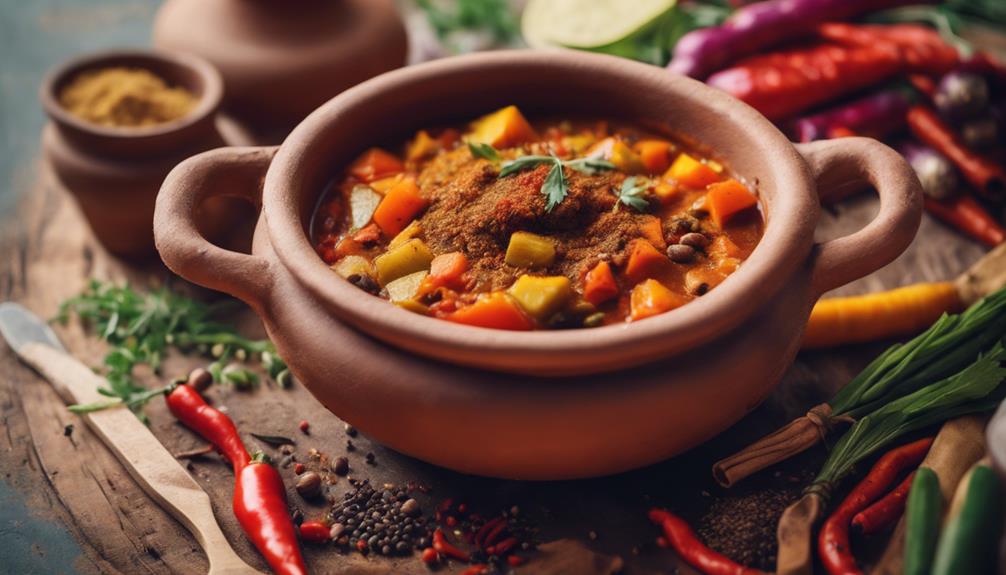
In conclusion, reflect on the robust flavors and heartiness of this Moroccan Spiced Vegetable Stew as you savor the delightful combination of spices and vegetables. The stew offers a sensory experience that goes beyond mere sustenance.
By exploring textures, you encounter a medley of tender vegetables and rich broth that create a satisfying mouthfeel. The flavor combinations in this stew are a harmonious blend of earthy cumin, warm cinnamon, and a hint of fiery cayenne, all coming together to tantalize your taste buds with each spoonful.
The interplay of sweet carrots, savory bell peppers, and hearty chickpeas adds depth to the dish, making each bite a journey through Moroccan culinary traditions. Whether you're a seasoned chef or a novice cook, this stew provides a comforting and flavorful meal that can be enjoyed on its own or paired with couscous or crusty bread.
Embrace the warmth and spice of Moroccan cuisine with this hearty vegetable stew, perfect for chilly evenings or gatherings with loved ones.
Frequently Asked Questions
Can This Stew Be Made Ahead of Time and Frozen for Later?
You can definitely make this stew ahead of time and freeze it for later. For best results, cool it completely before freezing. When you reheat it, you may want to adjust the spices to suit your taste.
Are There Any Recommended Side Dishes to Serve With This Stew?
For a balanced meal with the stew, consider pairing it with flavorful breads or invigorating salads. You can also complement it with savory appetizers or sweet desserts to create a satisfying dining experience. Enjoy your culinary adventure!
Can I Substitute Any of the Vegetables in the Recipe?
You can definitely substitute veggies in the recipe for ingredient swaps. Get creative with flavor variations by trying different vegetables. Adjust seasoning accordingly to guarantee a tasty dish. Experiment with cooking techniques to suit your preferences.
What Is the Best Way to Store Leftovers of the Stew?
To store leftovers of the stew, consider freezing tips for long-term storage. Use airtight containers or freezer bags for preservation. When ready to enjoy, reheat by simmering on the stovetop or microwaving in short intervals.
Can I Adjust the Level of Spiciness in the Stew to My Liking?
To adjust the spiciness levels in the stew to your liking, consider adding or reducing the amount of spices used. Customizing flavors allows you to tailor the dish to match your preferred level of heat.
Conclusion
Overall, Moroccan cuisine is known for its bold flavors, rich spices, and colorful ingredients.
The Moroccan spiced vegetable stew is a delicious example of this culinary tradition. By incorporating warm spices like cumin and cinnamon, this dish creates a unique and satisfying taste experience.
Whether you're a fan of vegetarian dishes or simply looking to explore new flavors, this Moroccan stew is sure to impress your taste buds. Try it out and transport yourself to the vibrant streets of Marrakech with each flavorful bite!
